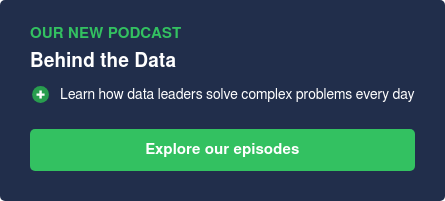Converting data from its original, raw format into structures optimized for analytics can be a challenge.
However, doing so successfully will offer a breadth of valuable information that can allow your business to implement new, innovative services.
ETL is often used both for referring to a piece of technology for moving and transforming data as well as the actual task of getting data from the source to the target, typically an analytic database, data warehouse or a data lake.
Download the article as a pdf
Share it with colleagues. Print it as a booklet. Read it on the plane.
What is ETL?
ETL stands for extract, transform and load and is used to combine data for long-term use into data warehouses, data hub or data lake structures. It's traditionally applied to known, pre-planned sources to organize and prepare data for traditional business intelligence and reporting.
It's a type of data integration that forms an important part of an organization's data flow process and can provide real value to enhancing business intelligence solutions for decision making.
It's essential to properly format and prepare data to load it in the data storage system of your choice.
This is why the ETL process is split into three distinct but interrelated steps to ensure every crucial function is adhered to.
Let's take a closer look at those functions.
How does the ETL process work?
A well-designed ETL strategy takes data from its source systems, implements a set of practices that ensures data quality, and then synthesizes the data. This means that that end-users can successfully make good business decisions. The three interconnected steps of ETL are:
- Extract. The first stage of the ETL process retrieves data from its source system into a single format appropriate for transformation processing. It's an important part of the process as it correctly sets the stage for the success of subsequent processes.
- Transform. This is the stage when a set of rules are applied to the extracted data (to ensure data quality and accessibility) to prepare it for the final stage in the process.
- Load. This stage is when the extracted and transformed data is loaded into the end target source of a data warehouse, data hub or data lake structure.

The ETL process has several advantages that can allow your business to accelerate transformation and boost growth, such as:
- Enabling business intelligence solutions for analytics and decision-making. Structured data is universally understood by end-users.
- Minimal disruption as the ETL process is run on a schedule that will consistently update a reporting warehouse.
- A variety of automated tools available that effectively process complex rules and transformations to improve productivity and streamline the process without additional technical skills.
- Context and data aggregations so that business can generate higher revenue and/or save money.
Knowing and understanding the data source - where to extract the data - and finding the right tool for the business is essential to making the most of ETL.
But ETL isn't your only option.
Let's have a look at another variant of data integration called ELT which switches things up a little.
The difference between ETL and ELT
ETL (extract, transform, load) and ELT (extract, load, transform) solve the same problem, but in a slightly different way.
So, what is the exact difference?
While the most obvious difference is the sequence of the steps, there's more to it than that.
ELT involves the transformations taking place after the data has been loaded.
Regardless of whether it's ETL or ELT, the data transformation/integration process involves the same steps.
But with ELT, while the extraction step takes place in the same way, the extracted data is then stored in a staging area or database, and any required business rules and data integrity checks can be run on the data in the staging area before it's loaded into the storage system - where finally all data transformations occur.
Because data transformations in ETL occur before the data is loaded, it's the ideal process for when a destination requires a specific data format. Whereas with ELT, organizations can transform their data at any time, when and as necessary for their use case, and not as a step in the data pipeline.
So, let's now look into which ETL tools your business could utilize.
What's the difference between data ingestion and ETL?3 examples of ETL tools
There are several ETL tools available to assist your organization with the movement and transformation of data. These include:
- Legacy/DIY ETL tools. When you go down the route of DIY ETL, things can progress quickly, but the process tends to be slower, less flexible and more costly. These tools tend to be code-intensive and lack the automation required to make a real difference.
- Open source ETL tools. These tools are much more flexible than legacy/DIY tools. They work on data of varying structures and formats. But while free tools are always tempting, in a lot of cases you get what you pay for.
- Enterprise or cloud-based ETL tools automate the process in a way that you can monitor, troubleshoot, and easily modify and adapt moving data. These tools can be more effective than than either DIY or open source ETL because they're generally more powerful and flexible and make it easier to automate processing of complex rules and transformations.
Homegrown ETL might save time looking for a third-party tool, but hand-coded data extraction can be very limiting, time-intensive, and prone to errors. Enterprise ETL tools automate the extraction, transformation and load processes to create a more efficient and reliable workflow.
Your business needs to understand its data and the insights that can help you achieve more. Fortunately, ETL tools take this data and transform it into a user-friendly format that unlocks the value of your applications, functions, and processes.
Developing an ETL strategy
ETL makes it possible for different types of data to work together and to transform it all into well-defined "rigid" structures that are optimized for analytics.
The most common mistake to make when designing and building an ETL solution is to jump into buying a new tool before having a comprehensive understanding of business requirements and needs.
For more on this, and more mistakes to avoid when choosing whether to build or buy an ETL solution, watch our webinar: Build vs Buy - Data Integration Platform or In-House Solution?







